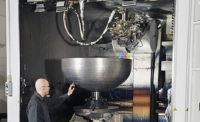The line between competitors and partners in the automotive industry has been blurring for many years. A good example of this is the Autoeuropa Automóveis Lda. assembly plant in Palmera, Portugal, near Lisbon.
Ford Europe and the Volkswagen Group jointly opened the facility in May 1995, after four years of preparation. But, Volkswagen became the plant’s sole owner and operator in December 1999, and has manufactured millions of cars there ever since. The company produced more than 100,000 vehicles in 2017, including the SEAT Alhambra and Volkswagen Sharan, Eos, Scirocco and T-Roc.
One reason for this high output level is Volkswagen 3D-prints nearly all of the tools, jigs and fixtures that are used on the assembly line. Prior to beginning this practice in 2014, Volkswagen relied solely on external suppliers for these manufacturing aids.
In-house 3D printing benefits the company in several ways, according to Miguel José, process engineer at Volkswagen Autoeuropa. It lowers tool-development costs by 91 percent and cuts lead times from several weeks to just a few days, thereby improving workflow and significantly increasing production.
Equally important, this approach gives tool designers more trial-and-error flexibility—regardless of whether they want to make small, large or multiple design changes. A designer can print a tool overnight, test it the next morning and then easily incorporate different iterations until the perfect tool is made. This tool can then be printed as many times as needed and at a
low cost.
Currently, the plant operates seven 3D printers made by Netherlands-based Ultimaker B.V. Luis Pascoa, pilot plant manager at Volkswagen Autoeuropa, says that the machines paid for themselves after only printing a handful of tools. Overall, in-house 3D printing helped the facility save nearly $150,000 in 2016 and $325,000 in 2017.
“Ultimaker [machines] offer a low-cost solution with high-quality results,” says Pascoa. “If you consider [their use for the] entire automotive industry, the potential is huge.”
Ultimaker offers six models of 3D printers, all of which use fused filament fabrication and allow end-users to print with any kind of filament material. The print head travels from 30 to 300 millimeters per second. Build speed reaches up to 8 cubic millimeters per second.
Model S5 is the company’s latest machine, and it features active bed leveling to ensure a perfect first layer. Also standard are controlled airflow, and a filament flow sensor that automatically pauses printing to notify the operator when no more material is available. The unit offers a build volume of 330 by 240 by 300 millimeters and layer-resolution ranges of 60 to 150, 20 to 200 and 20 to 600 microns.
Ultimaker 3 has the same resolution capabilities, but with a build volume of 215 by 215 by 200 millimeters. The 2+ and 2+ Extended models have a fourth resolution range of 20 to 400 microns. Four nozzle sizes are available, with build speeds of either 8, 16, 23 or 24 cubic millimeters per second.
The company’s Original and Original+ machines have a single layer resolution of 20 to 200 microns, and a build volume of 210 by 210 by 205 millimeters. For more information on 3D printers, call 888-229-9046 or visit https://ultimaker.com.








